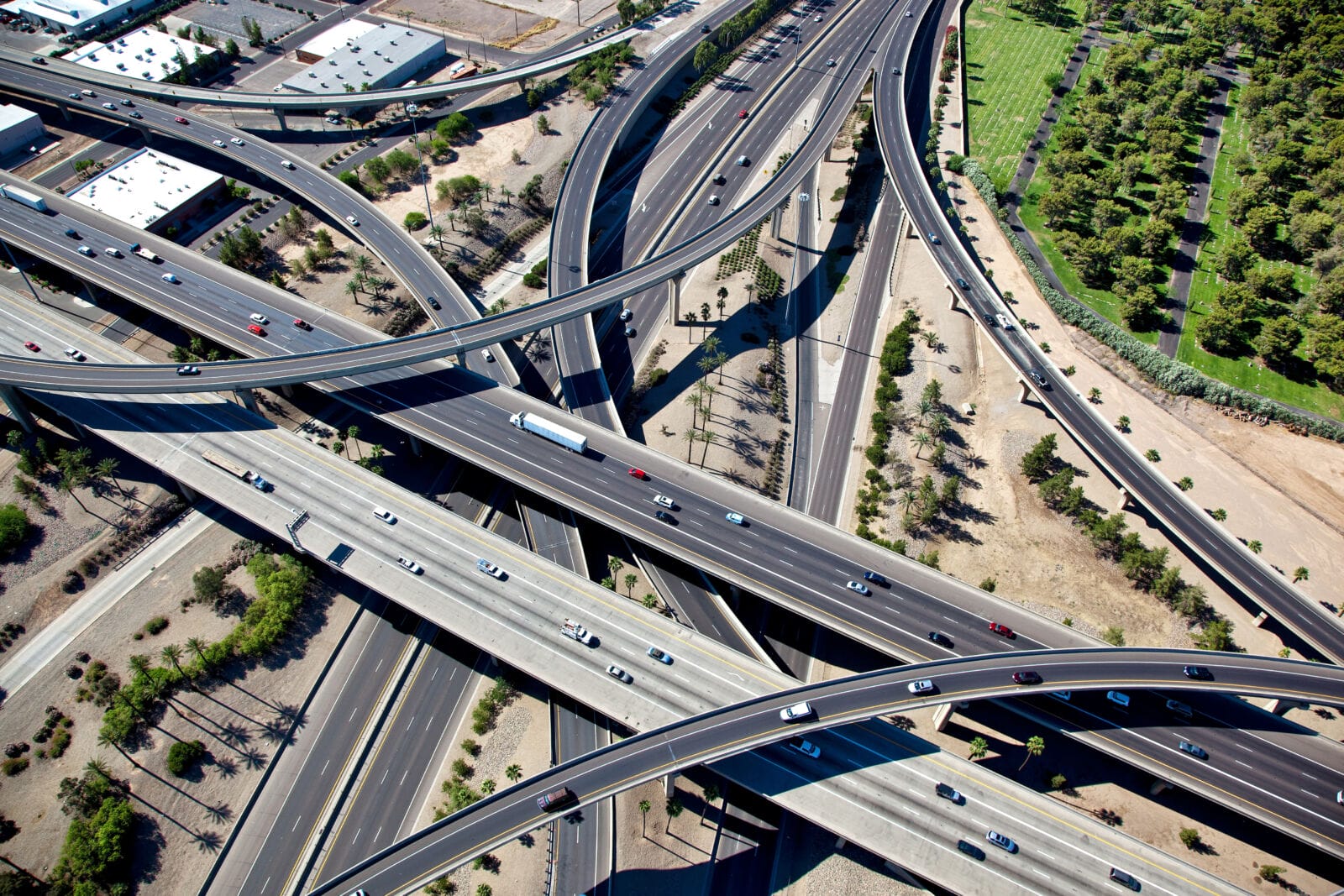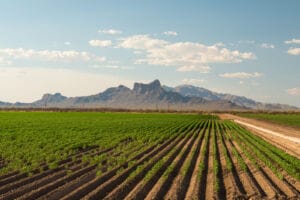Viewing a map of Greater Phoenix reveals an efficient transportation system, with streets forming a neat grid that connect to multiple highways, making travel around the Valley quick and convenient. This network came about thanks to the planning and funding provided by a half-cent sales tax approved by voters with the passage of Prop 300 in 1985, then through an extension of that tax in 2004 with Proposition 400. In November, voters will weigh in once again on whether to continue investing in the region’s transportation infrastructure with Prop 479.
“We need to continue to remind ourselves that 39 years ago, before Prop 300 was passed, I-10 was not connected in the City of Phoenix,” says Clark Princell, president and CEO of Valley Partnership. “That’s how far we’ve come on infrastructure. Through Prop 300 and Prop 400, we’ve also built Loops 101, 202, 303 and [State Route] 51, not to mention light rail. This didn’t happen by accident — there was thoughtful effort by folks throughout the business and public sectors all leveraging resources to build the transportation system we have today and all the benefits we derive from it.”
Indeed, a Maricopa Association of Governments (MAG) report shows that the investments made through Propositions 300 and 400 have had a material impact on the region, with a 25% reduction in average travel time by freeway and 105 hours saved from traffic each year per driver. These transportation corridors have also had a positive effect on property values, with a 212% increase on parcels within a quarter mile of a freeway and a 316% increase for locations the same distance from a light rail line.
Attracting Development
Building an efficient and well-maintained transportation system is a benefit for all those who live in the region, making travel convenient. But having this network in place is also an asset when attracting businesses to Greater Phoenix. A MAG report notes that 890 of 950 Greater Phoenix Economic Council locates between 1990 and 2021 were within two miles of a freeway corridor.
“Transportation is a critical pillar of economic development,” says Jaye O’Donnell, economic development director for the City of Mesa. “Strong connectivity and future planning for transportation is necessary for any community’s vibrancy, growth and sustainability.”
READ ALSO: Here’s how extending Proposition 400 benefits Arizona’s economy
The development that has sprouted up around the Loops 101 and 202, such as the Falcon District in the northern part of Mesa, continues to bring high-wage jobs to the city. In Southeast Mesa, Elliot Road Technology Corridor and the Mesa Gateway area have been areas of significant investment, which was made possible, O’Donnell says, because of the Loop 202 and SR 24.
John Bullen, chief transportation officer for MAG, says there is a direct correlation between the economic development activity that has taken place in the Valley and the transportation investments set into motion after Proposition 300’s passage in 1985.
“Regardless of what economic indicator that you look at — whether it’s land appreciation, job locates, commute times — transportation drives it all,” he explains. “It’s fair to say that Prop 400 and Prop 300 before that has played an instrumental role in the economic vitality we see today.”
In a recent example, the revenue made available through the half-cent sales tax gave the Arizona Department of Transportation (ADOT) the funds to quickly make the road improvements needed to support TSMC’s manufacturing facility in North Phoenix, according to a MAG report.
“In summer 2020, regional funding was programmed to design, acquire right of way and construct [interchanges at Loop 303 and 51st Avenue and 43rd Avenue],” the report reads. “The availability of regional sales tax funding allowed ADOT to respond quickly to the need; reliance on statewide revenues would have likely resulted in a multiyear delay, potentially putting the TSMC facility locate at risk.”
High Stakes Decision
Prior to Proposition 300, the only existing revenue streams for roads came from the Highway User Revenue Fund (HURF) and federal dollars that flow into Arizona, Bullen notes. Without an additional funding source, leaders in the 1980s projected that it would take 60 years to build the Loop 101, highlighting the importance of the half-cent sales tax to the region’s transportation system.
“Without it,” Bullen says, “all funding will have to be consolidated and focused on maintaining the existing infrastructure. We’re projected to grow by 1.7 million people by 2050, and [without Prop 479] we will not be able to add additional highway infrastructure to support that growth.”
Beyond increased congestion on the roads, the half-cent sales tax also funds paratransit and is an important funding stream for regional bus service. Local agencies have also become increasingly dependent on those funds for rehabilitating roadways to make them safer or easier to travel on. This need also coincides with shrinking HURF funds, which are collected based off gas taxes and vehicle-related fees.
“HURF was designed in the 1970s to be the primary funding source for roadway and highway improvements in Arizona,” Bullen notes. “As cars have become more fuel efficient, as people look at other modes [of transportation] and people drive less because gas prices are higher, the amount of revenue is not meeting the demand.”
Controlling for inflation, 2021 HURF collections were lower than in 2000, while the state’s population grew more than 40% over that period. If the half-cent sales tax is not extended through Prop 479 and new roadway infrastructure isn’t built, MAG projects that local sales will decline by $4.5 billion per year, businesses will have higher travel costs totaling upwards of $40 billion and shipping and logistics costs will increase by $4.4 billion. About 32,000 jobs will be lost per year, with 71% of those jobs falling into the median-to-high wage threshold.
A Public Good
Should voters choose to pass Prop 479 and extend the half-cent sales tax, the region will continue to have the capacity to make the infrastructure investments needed to ensure continued prosperity in the region. This includes 331 new freeway miles, three new or improved system interchanges, 43 new or improved traffic interchanges and 1,000 new or improved arterial lane miles.
In the North Valley, Bullen notes that while funds from Proposition 400 built the initial infrastructure to support TSMC’s manufacturing facility, more needs to be done in the area.
“The Loop 303 is still an interim facility, so it’s only two lanes. We have to finish that, then build the system interchange with the I-17,” he explains. “Right now, traffic has to get off on I-17 and use a local roadway to make a left turn. It’s inefficient — traffic is starting to back up on the I-17 just from construction workers, let alone what you’ll see once employees start going to that facility.”
State Route 30 is another major project that will be built if Prop 479 passes. The freeway will be about five miles south of the I-10 and run parallel with the interstate from SR 85 in Buckeye to the I-17 in Phoenix — approximately 29 miles.
“That section of I-10 is extremely congested, and there are limited things we can do [directly] to I-10,” Bullen says. “We can make some improvements here and there, but really the improvement is going to come from the construction of State Route 30. We have that funded in the first phase of the [regional transportation] plan, and we’ve been acquiring right of way to get that corridor prepped. That facility is ready for primetime, we just need a funding stream to go construct.”
In Mesa, SR 24 is also slated for further investment, as it is currently an interim facility and the surrounding area is experiencing significant growth.
“We really need [Prop 479] to pass,” O’Donnell says. “Once it does, the improvements to SR 24 will save motorists millions of dollars in travel savings. It’s already helping so many people get from Southeast Mesa and Queen Creek into other job centers. It had a positive impact, and we’re hoping we can make it even better.”
The need to make these infrastructure investments to stay ahead of growth is imperative, Princell says. He points to other regions which have neglected to do so and says those places struggle with gridlock and the inability to move goods and people around the region.
“Frankly, people are not going to stop moving here,” Princell concludes. “Prop 479 puts a choice in front of us. Do we continue to invest in infrastructure to ensure the people coming — and those who already live here — can continue to move around in an efficient manner? Or do we take a pause and just allow more people try to make do with the same infrastructure we have today?”




